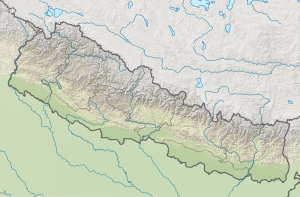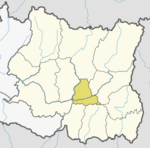|
Chaubise Rural Municipality
Chaubise (Nepali: चौबिसे) is a rural municipality (gaunpalika) out of four rural municipality located in Dhankuta District of the Koshi Province of Nepal. There are a total of 7 municipalities in Dhankuta in which 3 are urban and 4 are rural. According to Ministry of Federal Affairs and Local Development Chaubise has an area of 147.6 square kilometres (57.0 sq mi) and the total population of the municipality is 19283 as of Census of Nepal 2011.[1][2] To form this new Rural Municipality 6 No. Budhabare, Mudebas, Kuruletenupa, Bodhe, Rajarani, Maunabuthuk and Basantatar were merged, which previously were all separate Village development committee (local level administrative villages).[3] Fulfilling the requirement of the new Constitution of Nepal 2015, Ministry of Federal Affairs and Local Development replaced all old VDCs and Municipalities into 753 new local level body (Municipality). The Gaunpalika is divided into 8 wards and the Rajarani, Dhankuta is the Headquarter of this newly formed rural municipality. DemographicsAt the time of the 2011 Nepal census, Chaubise Rural Municipality had a population of 19,283. Of these, 32.6% spoke Limbu, 29.0% Nepali, 15.8% Magar, 7.8% Yakkha, 6.2% Tamang, 3.9% Yamphu, 2.1% Rai, 0.6% Majhi, 0.4% Newar, 0.3% Bantawa, 0.2% Bhujel, 0.2% Gurung, 0.2% Maithili, 0.1% Chamling, 0.1% Sanskrit, 0.1% Tharu and 0.4% other languages as their first language.[4] In terms of ethnicity/caste, 33.6% were Limbu, 15.9% Magar, 11.5% Chhetri, 8.8% Yakkha, 6.5% Tamang, 4.6% Hill Brahmin, 3.6% Rai, 3.5% Kami, 3.3% Yamphu, 3.2% Newar, 1.7% Damai/Dholi, 1.2% Majhi, 0.7% Sanyasi/Dasnami, 0.5% Gurung, 0.5% Sarki, 0.4% Gharti/Bhujel, 0.1% Badi, 0.1% Tharu and 0.4% others.[5] In terms of religion, 45.9% were Kirati, 33.2% Hindu, 18.5% Buddhist, 1.6% Christian, 0.1% Prakriti and 0.7% others.[6] In terms of literacy, 73.8% could read and write, 1.9% could only read and 24.3% could neither read nor write.[7] References
External links
|
||||||||||||||||||||||||||||||||||||||||||||


